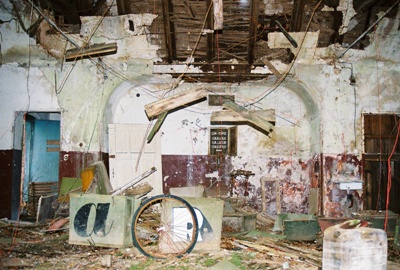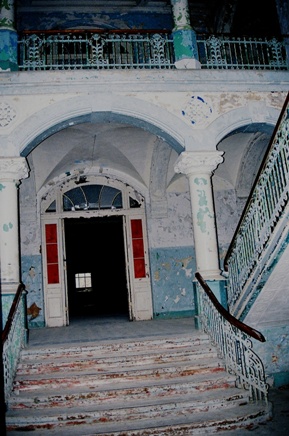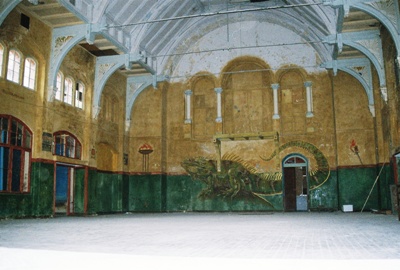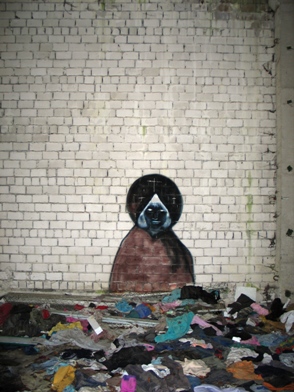skip to main |
skip to sidebar
 While southwestern New Mexico burns, covering much of the state in dingy smoke, I think we’ll stay overseas and visit Beelitz Heilstätten, a 200-acre hospital complex comprised of 60 buildings and located in the town of Beelitz, just a few kilometers south of Potsdam. Beelitz’s other claim to fame is its delicious white asparagus, but as pictures of asparagus aren’t always interesting, we spent all our time at the hospital.
The Beelitz Heilstätten complex (“Heilstätten” translates roughly as “a place of healing) was constructed in 1898 and designed by Heino Schmieden, partner in one of Berlin’s greatest architecture firms of the time. Aside from the numerous ornate buildings, rigorously separated by gender, the grand complex also contained its own generating station to produce power and heat. Below is the entrance to the men's sanatorium.
While southwestern New Mexico burns, covering much of the state in dingy smoke, I think we’ll stay overseas and visit Beelitz Heilstätten, a 200-acre hospital complex comprised of 60 buildings and located in the town of Beelitz, just a few kilometers south of Potsdam. Beelitz’s other claim to fame is its delicious white asparagus, but as pictures of asparagus aren’t always interesting, we spent all our time at the hospital.
The Beelitz Heilstätten complex (“Heilstätten” translates roughly as “a place of healing) was constructed in 1898 and designed by Heino Schmieden, partner in one of Berlin’s greatest architecture firms of the time. Aside from the numerous ornate buildings, rigorously separated by gender, the grand complex also contained its own generating station to produce power and heat. Below is the entrance to the men's sanatorium.
 Conceived as a tuberculosis sanatorium by the Berlin Workers’ Health Insurance Corporation, the main treatments seem to have been “baths.” Water baths in pools, air baths on balconies, just generally taking it easy, I guess. There wasn’t much in the way of effective surgery at the time, of course, and the grounds appear to have mostly been designed with extended strolls in mind.
Then, at the beginning of WWI, the complex quickly became a military hospital for the Imperial German Army. Perhaps the most (in)famous patient to stay at Beelitz Heilstätten during this time was Adolf Hitler who, after being wounded in the leg at the Battle of the Somme, spent October and November of 1916 recuperating here.
Conceived as a tuberculosis sanatorium by the Berlin Workers’ Health Insurance Corporation, the main treatments seem to have been “baths.” Water baths in pools, air baths on balconies, just generally taking it easy, I guess. There wasn’t much in the way of effective surgery at the time, of course, and the grounds appear to have mostly been designed with extended strolls in mind.
Then, at the beginning of WWI, the complex quickly became a military hospital for the Imperial German Army. Perhaps the most (in)famous patient to stay at Beelitz Heilstätten during this time was Adolf Hitler who, after being wounded in the leg at the Battle of the Somme, spent October and November of 1916 recuperating here.
 After being used as a Nazi military hospital during WWII, Beelitz Heilstätten was occupied by the Soviets in 1945 and, at its height, employed 1,000 people. Strangely, it remained a Russian-operated facility until 1995, a few years after German re-unification. In fact, shortly after the fall of the Berlin Wall, in December 1990, Erich Honecker spent time here. He had just been forced to resign as head of the suddenly non-existent East German government and apparently wasn’t feeling too good about things. I suppose the liver cancer probably didn’t help.
It was also during the unsettled period between the Wall coming down and re-unification that Die Bestie Von Beelitz or, The Beast of Beelitz, appeared. From the fall of 1989 to the spring of 1991, the Beast, a necrophiliac, terrorized the women of Beelitz, strangling or stabbing his victims and at least once leaving his own pink underwear behind.
After being used as a Nazi military hospital during WWII, Beelitz Heilstätten was occupied by the Soviets in 1945 and, at its height, employed 1,000 people. Strangely, it remained a Russian-operated facility until 1995, a few years after German re-unification. In fact, shortly after the fall of the Berlin Wall, in December 1990, Erich Honecker spent time here. He had just been forced to resign as head of the suddenly non-existent East German government and apparently wasn’t feeling too good about things. I suppose the liver cancer probably didn’t help.
It was also during the unsettled period between the Wall coming down and re-unification that Die Bestie Von Beelitz or, The Beast of Beelitz, appeared. From the fall of 1989 to the spring of 1991, the Beast, a necrophiliac, terrorized the women of Beelitz, strangling or stabbing his victims and at least once leaving his own pink underwear behind. Most of the attacks occurred near the surgical block and women’s pavilion on the forested Heilstätten grounds and his victims included the wife and infant child of a senior physician. Before being detained by joggers while pleasuring himself in the woods, the Beast, whose real name is Wolfgang Schmidt, killed a total of six women and the infant. He was sentenced to 15 years detention in a psychiatric facility which seems a little, I don’t know, LIGHT to me. However, I believe he remains imprisoned now, 20+ years later. A QUOTE from 2001 has Schmidt asking the court that he be treated as a woman named "Beate" (the court agreed) and complaining about taunting by other inmates.
As if all that wasn’t enough, in 2008, a pornographer brought a young model named Anja P. to the former operating suite for a photo session. After the shoot he took her to the gatehouse where he beat her to death with a frying pan and had sex with her corpse. The head of a family that actually lives in an outbuilding on the grounds, Michael W. says he and his son are both martial arts experts and “could handle about eight people together and win.” Geez, those are the kind of skills you just might need if you’re going to spend much time around Beelitz Heilstätten. That's a gymnasium in the photo below.
Most of the attacks occurred near the surgical block and women’s pavilion on the forested Heilstätten grounds and his victims included the wife and infant child of a senior physician. Before being detained by joggers while pleasuring himself in the woods, the Beast, whose real name is Wolfgang Schmidt, killed a total of six women and the infant. He was sentenced to 15 years detention in a psychiatric facility which seems a little, I don’t know, LIGHT to me. However, I believe he remains imprisoned now, 20+ years later. A QUOTE from 2001 has Schmidt asking the court that he be treated as a woman named "Beate" (the court agreed) and complaining about taunting by other inmates.
As if all that wasn’t enough, in 2008, a pornographer brought a young model named Anja P. to the former operating suite for a photo session. After the shoot he took her to the gatehouse where he beat her to death with a frying pan and had sex with her corpse. The head of a family that actually lives in an outbuilding on the grounds, Michael W. says he and his son are both martial arts experts and “could handle about eight people together and win.” Geez, those are the kind of skills you just might need if you’re going to spend much time around Beelitz Heilstätten. That's a gymnasium in the photo below.
 Recently, there have been some efforts to privatize the complex but bankruptcy has gotten in the way. The surgery, psychiatric ward, and rifle range (??) have been abandoned for some time and a supposedly functioning center for neurological research and a rehabilitation area for Parkinson’s sufferers were not obviously operating during our visit.
Recently, there have been some efforts to privatize the complex but bankruptcy has gotten in the way. The surgery, psychiatric ward, and rifle range (??) have been abandoned for some time and a supposedly functioning center for neurological research and a rehabilitation area for Parkinson’s sufferers were not obviously operating during our visit. In fact, aside from the caretaker’s quarters and some random renovation here and there, we saw virtually no activity. Unfortunately for us—and in contrast to statements from a year or two ago—most of the buildings were locked-up, boarded-over, and totally inaccessible without more time and at least a rope or two. Still, it was quite an experience to wander the grounds on a damp, overcast day, take in the unusual Russian graffiti, and consider all the terrible goings-on that have occurred at Beelitz Heilstätten.
Although I had not heard of Beelitz Heilstätten before visiting, it turns out to be quite well known indeed. I found very good information and the Michael K. quote at EXBERLINER, this URB EX site was informative, and I grabbed some info on Schmidt from HERE. If you want to see some more of Beelitz Heilstätten complex, just do a Google search. It's all over the place. The complex has also appeared in both The Pianist and Valkyrie, as well as some S&M films. But you’re on your own if you want to get the names of those.
In fact, aside from the caretaker’s quarters and some random renovation here and there, we saw virtually no activity. Unfortunately for us—and in contrast to statements from a year or two ago—most of the buildings were locked-up, boarded-over, and totally inaccessible without more time and at least a rope or two. Still, it was quite an experience to wander the grounds on a damp, overcast day, take in the unusual Russian graffiti, and consider all the terrible goings-on that have occurred at Beelitz Heilstätten.
Although I had not heard of Beelitz Heilstätten before visiting, it turns out to be quite well known indeed. I found very good information and the Michael K. quote at EXBERLINER, this URB EX site was informative, and I grabbed some info on Schmidt from HERE. If you want to see some more of Beelitz Heilstätten complex, just do a Google search. It's all over the place. The complex has also appeared in both The Pianist and Valkyrie, as well as some S&M films. But you’re on your own if you want to get the names of those.
 While southwestern New Mexico burns, covering much of the state in dingy smoke, I think we’ll stay overseas and visit Beelitz Heilstätten, a 200-acre hospital complex comprised of 60 buildings and located in the town of Beelitz, just a few kilometers south of Potsdam. Beelitz’s other claim to fame is its delicious white asparagus, but as pictures of asparagus aren’t always interesting, we spent all our time at the hospital.
The Beelitz Heilstätten complex (“Heilstätten” translates roughly as “a place of healing) was constructed in 1898 and designed by Heino Schmieden, partner in one of Berlin’s greatest architecture firms of the time. Aside from the numerous ornate buildings, rigorously separated by gender, the grand complex also contained its own generating station to produce power and heat. Below is the entrance to the men's sanatorium.
While southwestern New Mexico burns, covering much of the state in dingy smoke, I think we’ll stay overseas and visit Beelitz Heilstätten, a 200-acre hospital complex comprised of 60 buildings and located in the town of Beelitz, just a few kilometers south of Potsdam. Beelitz’s other claim to fame is its delicious white asparagus, but as pictures of asparagus aren’t always interesting, we spent all our time at the hospital.
The Beelitz Heilstätten complex (“Heilstätten” translates roughly as “a place of healing) was constructed in 1898 and designed by Heino Schmieden, partner in one of Berlin’s greatest architecture firms of the time. Aside from the numerous ornate buildings, rigorously separated by gender, the grand complex also contained its own generating station to produce power and heat. Below is the entrance to the men's sanatorium.
 Conceived as a tuberculosis sanatorium by the Berlin Workers’ Health Insurance Corporation, the main treatments seem to have been “baths.” Water baths in pools, air baths on balconies, just generally taking it easy, I guess. There wasn’t much in the way of effective surgery at the time, of course, and the grounds appear to have mostly been designed with extended strolls in mind.
Then, at the beginning of WWI, the complex quickly became a military hospital for the Imperial German Army. Perhaps the most (in)famous patient to stay at Beelitz Heilstätten during this time was Adolf Hitler who, after being wounded in the leg at the Battle of the Somme, spent October and November of 1916 recuperating here.
Conceived as a tuberculosis sanatorium by the Berlin Workers’ Health Insurance Corporation, the main treatments seem to have been “baths.” Water baths in pools, air baths on balconies, just generally taking it easy, I guess. There wasn’t much in the way of effective surgery at the time, of course, and the grounds appear to have mostly been designed with extended strolls in mind.
Then, at the beginning of WWI, the complex quickly became a military hospital for the Imperial German Army. Perhaps the most (in)famous patient to stay at Beelitz Heilstätten during this time was Adolf Hitler who, after being wounded in the leg at the Battle of the Somme, spent October and November of 1916 recuperating here.
 After being used as a Nazi military hospital during WWII, Beelitz Heilstätten was occupied by the Soviets in 1945 and, at its height, employed 1,000 people. Strangely, it remained a Russian-operated facility until 1995, a few years after German re-unification. In fact, shortly after the fall of the Berlin Wall, in December 1990, Erich Honecker spent time here. He had just been forced to resign as head of the suddenly non-existent East German government and apparently wasn’t feeling too good about things. I suppose the liver cancer probably didn’t help.
It was also during the unsettled period between the Wall coming down and re-unification that Die Bestie Von Beelitz or, The Beast of Beelitz, appeared. From the fall of 1989 to the spring of 1991, the Beast, a necrophiliac, terrorized the women of Beelitz, strangling or stabbing his victims and at least once leaving his own pink underwear behind.
After being used as a Nazi military hospital during WWII, Beelitz Heilstätten was occupied by the Soviets in 1945 and, at its height, employed 1,000 people. Strangely, it remained a Russian-operated facility until 1995, a few years after German re-unification. In fact, shortly after the fall of the Berlin Wall, in December 1990, Erich Honecker spent time here. He had just been forced to resign as head of the suddenly non-existent East German government and apparently wasn’t feeling too good about things. I suppose the liver cancer probably didn’t help.
It was also during the unsettled period between the Wall coming down and re-unification that Die Bestie Von Beelitz or, The Beast of Beelitz, appeared. From the fall of 1989 to the spring of 1991, the Beast, a necrophiliac, terrorized the women of Beelitz, strangling or stabbing his victims and at least once leaving his own pink underwear behind. Most of the attacks occurred near the surgical block and women’s pavilion on the forested Heilstätten grounds and his victims included the wife and infant child of a senior physician. Before being detained by joggers while pleasuring himself in the woods, the Beast, whose real name is Wolfgang Schmidt, killed a total of six women and the infant. He was sentenced to 15 years detention in a psychiatric facility which seems a little, I don’t know, LIGHT to me. However, I believe he remains imprisoned now, 20+ years later. A QUOTE from 2001 has Schmidt asking the court that he be treated as a woman named "Beate" (the court agreed) and complaining about taunting by other inmates.
As if all that wasn’t enough, in 2008, a pornographer brought a young model named Anja P. to the former operating suite for a photo session. After the shoot he took her to the gatehouse where he beat her to death with a frying pan and had sex with her corpse. The head of a family that actually lives in an outbuilding on the grounds, Michael W. says he and his son are both martial arts experts and “could handle about eight people together and win.” Geez, those are the kind of skills you just might need if you’re going to spend much time around Beelitz Heilstätten. That's a gymnasium in the photo below.
Most of the attacks occurred near the surgical block and women’s pavilion on the forested Heilstätten grounds and his victims included the wife and infant child of a senior physician. Before being detained by joggers while pleasuring himself in the woods, the Beast, whose real name is Wolfgang Schmidt, killed a total of six women and the infant. He was sentenced to 15 years detention in a psychiatric facility which seems a little, I don’t know, LIGHT to me. However, I believe he remains imprisoned now, 20+ years later. A QUOTE from 2001 has Schmidt asking the court that he be treated as a woman named "Beate" (the court agreed) and complaining about taunting by other inmates.
As if all that wasn’t enough, in 2008, a pornographer brought a young model named Anja P. to the former operating suite for a photo session. After the shoot he took her to the gatehouse where he beat her to death with a frying pan and had sex with her corpse. The head of a family that actually lives in an outbuilding on the grounds, Michael W. says he and his son are both martial arts experts and “could handle about eight people together and win.” Geez, those are the kind of skills you just might need if you’re going to spend much time around Beelitz Heilstätten. That's a gymnasium in the photo below.
 Recently, there have been some efforts to privatize the complex but bankruptcy has gotten in the way. The surgery, psychiatric ward, and rifle range (??) have been abandoned for some time and a supposedly functioning center for neurological research and a rehabilitation area for Parkinson’s sufferers were not obviously operating during our visit.
Recently, there have been some efforts to privatize the complex but bankruptcy has gotten in the way. The surgery, psychiatric ward, and rifle range (??) have been abandoned for some time and a supposedly functioning center for neurological research and a rehabilitation area for Parkinson’s sufferers were not obviously operating during our visit. In fact, aside from the caretaker’s quarters and some random renovation here and there, we saw virtually no activity. Unfortunately for us—and in contrast to statements from a year or two ago—most of the buildings were locked-up, boarded-over, and totally inaccessible without more time and at least a rope or two. Still, it was quite an experience to wander the grounds on a damp, overcast day, take in the unusual Russian graffiti, and consider all the terrible goings-on that have occurred at Beelitz Heilstätten.
Although I had not heard of Beelitz Heilstätten before visiting, it turns out to be quite well known indeed. I found very good information and the Michael K. quote at EXBERLINER, this URB EX site was informative, and I grabbed some info on Schmidt from HERE. If you want to see some more of Beelitz Heilstätten complex, just do a Google search. It's all over the place. The complex has also appeared in both The Pianist and Valkyrie, as well as some S&M films. But you’re on your own if you want to get the names of those.
In fact, aside from the caretaker’s quarters and some random renovation here and there, we saw virtually no activity. Unfortunately for us—and in contrast to statements from a year or two ago—most of the buildings were locked-up, boarded-over, and totally inaccessible without more time and at least a rope or two. Still, it was quite an experience to wander the grounds on a damp, overcast day, take in the unusual Russian graffiti, and consider all the terrible goings-on that have occurred at Beelitz Heilstätten.
Although I had not heard of Beelitz Heilstätten before visiting, it turns out to be quite well known indeed. I found very good information and the Michael K. quote at EXBERLINER, this URB EX site was informative, and I grabbed some info on Schmidt from HERE. If you want to see some more of Beelitz Heilstätten complex, just do a Google search. It's all over the place. The complex has also appeared in both The Pianist and Valkyrie, as well as some S&M films. But you’re on your own if you want to get the names of those.
2 comments:
Very interesting. I was totally enthralled by the history and pictures.
Thanks, Adsila! By the way, I just added Above the Norm to my...blogroll (or whatever they call those things).
Post a Comment